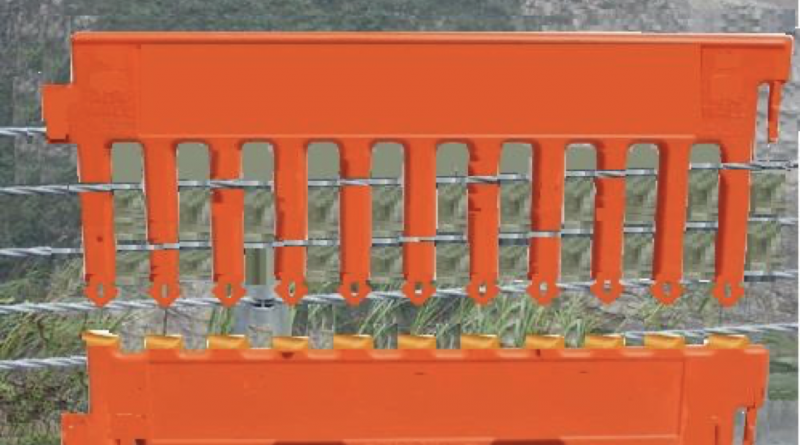‘Plastic combs’ may make wire rope safer
Recycled plastic inserts that look like combs could make wire rope barriers safer for motorcyclists, says a long-time motorcycling advocate.
Motorcycle Safety Consultant John Nelson, 63, has long campaigned against WRBs and recently warned of the rollout of higher wire rope barriers which could be even more dangerous to riders.
John believes he has an answer to the ongoing rollout of WRBs that many riders consider dangerous and have referred to as “cheese graters”, people slicers”, etc.
The device, made by Indian company TDCO Design, uses recycled plastic to form a “comb” that is inserted into the WRB with a bottom rail snapped into the bottom gap.

“I think it would reduce the instance of riders going through a barrier with an impact absorbing element,” John says.
“I’m in contact with the people who design this and I have been influential in the design and development of this. So far, this seems like a solution.”
In fact, the company has even dubbed it “The Nelson Comb” and made John the sole Australian agent for the technology concept.
“Given that our road authorities are reluctant to remove WRB for the small number of incidents, this concept should satisfy their love affair with WRB and given my passion for our safety, I think the authorities would have to at least have a think about it,” he says.
“I’m happy enough to accept a compromise that satisfies everyone. TNC is better than nothing.”
John hopes to sell the concept to VicRoads and all state road authorities.
“The TNC program is in its infancy. Further development, manufacture and testing is yet to be done,” he says.
WRBs lethal 
TDCO Design spokesman Takniki Drishti says WRBs can potentially be lethal to motorcyclists and other road users.
“The wire ropes are under tension and can therefore inflict unexpected reaction on small-sized vehicles crashing into them,” he says.
“The reaction can possibly be deadly – in their ability to flip vehicles crashing into them, due to their inherent elasticity.
“And worse, probably even of fatally slicing away limbs or head of any unfortunate motorcyclist who might get caught by the wire-ropes, like an apple.
“When a Motorcyclist takes a spill, he is either sent headlong in an uncontrolled fashion down the road, or crashes into and impacts the wire-ropes with considerable momentum.
“Due to the twisted form of the wire ropes and the weight and momentum of the human body, a deadly abrasive effect can possibly be applied on contact with soft Human tissue, with the wire rope acting like a garrotte.
“There is also a possibility of the wire-rope flexing and springing back, like bungee-cords, flinging the victim back dangerously into streaming traffic, in a trampoline effect, neither allowing the victim a chance for recovery, nor time for reaction by following motorists.”
Safer barriers
Tankiki says their recycled plastic barricade “combs” or “TNC” could prevent high-speed impact ricochets and body contact with the wire rope.
“The plastic barricades dove-tail into each other along the length of the WRBs, giving it the much-needed stiffness to prevent acting like bungee-cords,” he says.
“The small size of vertical openings (to reduce weight) would be too small for flailing limbs or the head getting caught during an uncontrolled impact.
“Vehicles heavier than a motorcycle would crush the hollow plastic barricade thereby absorbing the kinetic energy that would otherwise possibly result in a dangerous ricochet.
“Replacing damaged sections would only require slotting-in a replacement.”
He also says the TDCO Design barricades are UV-resistant and come in different colours to break the monotony and “brighten up the landscape”.
Founder Alex Thomas says they will not manufacturers he products as they are engineering designers, but they hope existing manufacturers will test and roll out the devices.
The post ‘Plastic combs’ may make wire rope safer appeared first on Motorbike Writer.



